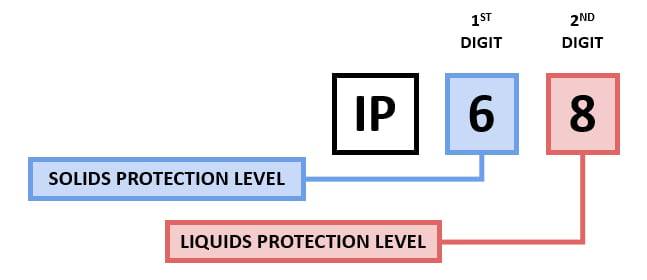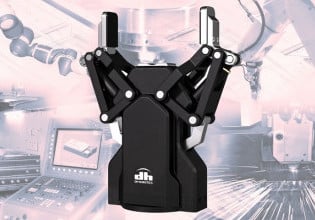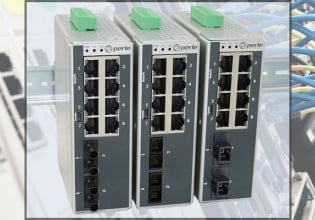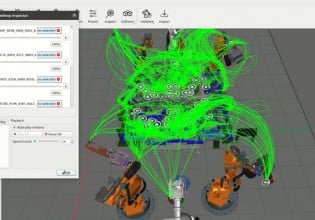Understanding Different IP Enclosure Ratings
This article will provide an overview of the IEC (International Electrotechnical Commission) IP (Ingress Protection) ratings, IEC standard 60529, sometimes referred to as International Protection code.
A previous article discussed common electrical enclosure ratings as defined by NEMA (National Equipment Manufacturers Association) standard 250, a standard primarily used in North America.

Enclosure label with dual ratings - NEMA and IEC IP. Image courtesy of Integra Enclosures.
Unlike NEMA ratings, IP ratings are more commonly used internationally and can be found in almost every country, including the United States. Due to its extensive popularity internationally, most major North American equipment and enclosure manufacturers will dual-rate their enclosures with NEMA and IEC IP ratings to appeal to a global market.
Reading the Chart
Unlike the NEMA Type enclosure ratings, which seem to use arbitrary numbers with random numeric assignments, the IP rating system is more systematic with a very defined structure. The IP ratings are primarily broken into two digits and in some occasions, an optional third letter or digit. The first number shown determines the level of protection against the invasion of solid objects into housing, with the lowest number offering no protection and the highest number offering the most amount of protection.
The second number determines the protection level against external liquids getting into the housing, and as with the first digit, a higher number indicates more protection.

IP (Ingress Protection) Rating Structure.
Theoretically, there could be upwards of 70+ different combinations of IP ratings and even more with the optional third digit or suffix. Practically though, the number of IP ratings that make it to the label of an enclosure seems to be more in line with a similar number of common NEMA ratings. The tables below define the first and second digit assignments and show how structured the IP rating system is.
1ST DIGIT - SOLIDS PROTECTION LEVEL
| 0 |
No protection |
| 1 |
Protection against solid objects > 50 mm, such as a hand |
| 2 |
Protection against solid objects > 12.5 mm, such as a finger |
| 3 |
Protection against solid objects > 2.5 mm, such as tools |
| 4 |
Protection against solid objects > 1.0 mm, such as wire or small screws |
| 5 |
Dust resistant, limited protection from the ingress of dust, ingress of dust not sufficient to cause harm |
| 6 |
Dust-tight, total protection from the ingress of dust |
Breakdown of the first digit of the IP Rating.
2ND DIGIT - LIQUID PROTECTION LEVEL
| 0 | No protection |
| 1 |
Protection against vertically dripping water, some ingress permitted |
| 2 |
Protection against dripping water with enclosure tilted up to a 15° angle |
| 3 |
Protection against spraying water |
| 4 |
Protection against splashing water |
| 5 |
Protection against jets of water directed at the enclosure |
| 6 |
Protection against powerful jets of water or heavy seas |
| 7 |
Protection against submission or exposure to water up to 1 m for a period of 30 minutes |
| 8 |
Protection against continuous submission or exposure to water up to 3 m |
| 9 |
Protection against high pressure and temperature water jet |
Breakdown of the second digit of the IP Rating.
I have seen some literature mentioning a third digit that indicates the degree of protection against mechanical impact. Still, it is not part of the IEC 60529 standard and is more commonly omitted than used.
NEMA Versus IP Ratings
NEMA and the IP rating systems define protection from solids and liquids (including frozen and semi-frozen liquids) entering an enclosure. However, the IP rating system does not consider other specifics such as corrosion and construction details, which the NEMA rating does.
The IP rating system also does not offer any equivalent to the NEMA explosion-proof enclosure ratings. These are some reasons why there is no true one to one comparison of NEMA ratings to IP ratings since each considers different factors and is organized in entirely different manners. It is usually possible to find a rough equivalent, though.
This can still be difficult, as can be seen in the table below.
| NEMA | IP |
| 1 | 10 |
| 2 | 11 |
| 3 | 54 |
| 3R |
14* / 32* |
| 3S |
54 |
|
4 & 4X |
66* / 68* |
| 5 | 52 |
|
6 & 6P |
67 & 68 |
|
12 & 12K |
52 |
| 13 | 54 |
NEMA versus IP Ratings from several different sources.
Several sources I researched listed other IP rating equivalents to some of the NEMA ratings. The cross-reference of IP ratings and NEMA ratings should be considered approximate, and the reader should take responsibility to verify the enclosure rating needed for each application.






